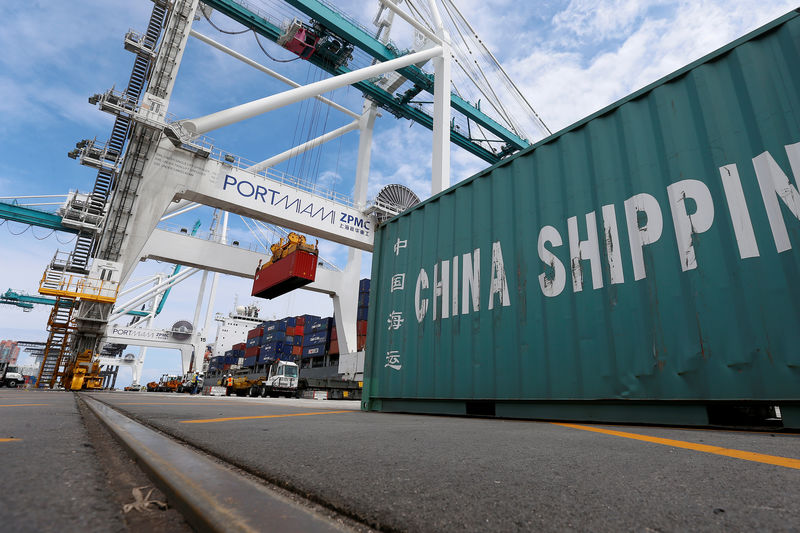By Lucia Mutikani
WASHINGTON (Reuters) - The U.S. trade deficit unexpectedly narrowed in April as imports and exports tumbled, leading economists to warn that the Trump administration's "America First" agenda was curbing trade between the United States and the rest of the world.
The report from the Commerce Department on Thursday does not capture a recent escalation in trade tensions between the U.S. and China, as well as with Mexico. President Donald Trump in early May slapped additional tariffs of up to 25% on $200 billion of Chinese goods, which prompted retaliation by Beijing.
Last week, Trump announced he would impose a tariff on all goods from Mexico in a bid to stem the tide of illegal immigration across the U.S.-Mexican border. Negotiations are ongoing to prevent the duties from kicking in at 5% on June 10.
"U.S. trade with the world is slowing dramatically and the odds are rising that the economy is going to take a big hit," said Chris Rupkey, chief economist at MUFG in New York.
"Globalization and expanded trade between nations benefited everyone and now the reductions in trade volumes between nations are going to subtract those benefits worldwide from everyone."The U.S. trade deficit fell 2.1% to $50.8 billion in April. Data for March was revised up to show the trade gap increasing to $51.9 billion instead of the previously reported $50.0 billion. Economists polled by Reuters had forecast the trade gap would widen to $50.7 billion in April.
The politically sensitive goods trade deficit with China surged 29.7% to $26.9 billion. The gap with Mexico fell 14.1% to $8.2 billion in April. Washington has secured a trade pact with Mexico and Canada, but there are fears it could be scuttled by Trump's intention to impose duties on Mexican goods.
Economists said waging trade wars with China and Mexico, both major U.S. trading partners, would exert more pressure on the economy, which is already slowing after being temporarily boosted by exports, an accumulation of inventories and defense spending in the first quarter.
"The president seems intent on imposing them (duties on Mexican goods)," said Joel Naroff, chief economist at Naroff Economic Advisors in Holland, Pennsylvania. "That would mean we would be fighting a two-front trade war and, if that lasts long, it is almost certainly going to sap the energy out of both consumers and businesses."
Federal Reserve Chairman Jerome Powell said on Tuesday the central bank was closely monitoring the implications of the trade tensions on the economy and would "act as appropriate to sustain the expansion."
The dollar fell against a basket of currencies, while U.S. Treasury prices were mostly trading higher. Stocks on Wall Street edged up.
BROAD WEAKNESS
Goods imports fell 2.5% to $208.7 billion in April, the lowest level since January 2018. The decline was broad, with imports of consumer goods dropping $1.1 billion. Imports of motor vehicles and capital goods also fell.
While the decline in imports would be a positive in the calculation of gross domestic product, weak imports suggest domestic demand was struggling to regain speed after slowing sharply in the first quarter. The drop in imports mirrors ongoing declines in manufacturing sentiment and production.
Goods exports tumbled 3.1% to $136.9 billion in April. The largest drop since January 2015 was led by a $2.3 billion plunge in civilian aircraft exports. Boeing (NYSE:BA) in March suspended deliveries of its 737 MAX jet after the aircraft was grounded indefinitely following two deadly crashes in five months. Production of the troubled plane has been cut.
There were also decreases in exports of consumer goods and motor vehicles in April. Exports of soybeans fell and further declines are likely following the escalation in trade tensions between Washington and Beijing.
China, the world's biggest buyer of soybeans, has previously targeted the crop in the trade war, only relenting when negotiations appeared to be progressing.
When adjusted for inflation, the goods trade deficit fell to $81.9 billion in April from $83.00 billion in the prior month. The drop in the so-called real goods trade deficit suggested that trade could add to economic growth this quarter.
"The trade deficit narrowed, but only because imports are falling more than exports," said Tim Quinlan, a senior economist at Wells Fargo (NYSE:WFC) Securities in Charlotte, North Carolina. "That is not a sustainable way for trade to lift a nation's economy."
The Atlanta Fed is forecasting GDP will rise at a 1.3% annualized rate in the second quarter. The economy grew at a 3.1% pace in the first quarter. Growth is cooling as the massive stimulus from last year's tax cuts and spending increases fades.
Despite the ebb in activity, the labor market is resilient.
A separate report on Thursday from the Labor Department showed initial claims for state unemployment benefits were unchanged at a seasonally adjusted 218,000 for the week ended June 1. The government's May employment report due on Friday is likely to show that nonfarm payrolls increased by 185,000 jobs in May after surging by 263,000 in April, according to a Reuters survey of economists.

But the tightening labor market is not generating a lot of wage inflation. Another report from the Labor Department showed unit labor costs, the price of labor per single unit of output, dropped at a 1.6% annualized rate in the first quarter, instead of falling at a 0.9% rate as reported last month.